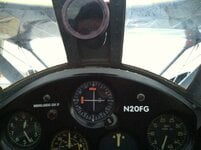GrauGeist
Generalfeldmarschall zur Luftschiff Abteilung
Vought lengthened the tailwheel strut when they made some changes to the F4U-1. Other changes were raising the seat seven inches and replacing the birdcage canopy with an improved version - this became the F4U-1A.Well, the Brits did fix the Corsair to suit their requirements. Clipped wings, raised tail wheel, centre-section drop tank, etc.
The FAA received their F4U-1As from Vought with clipped wings (eight inches removed), so they'd fit on RN carriers.


